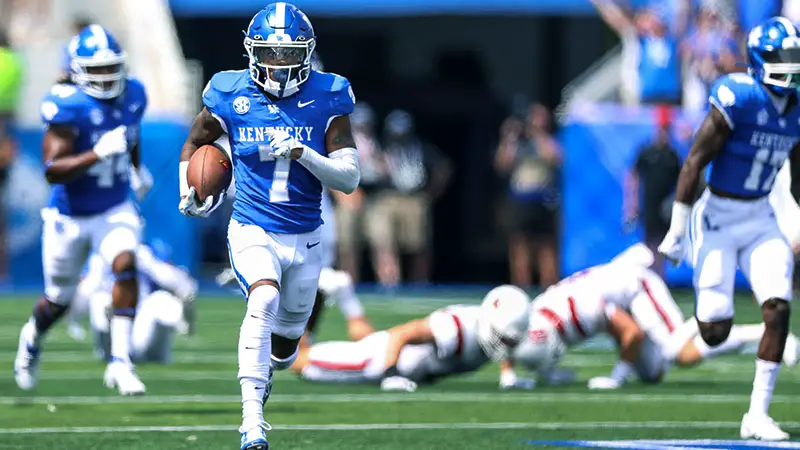Football kick returns are exhilarating moments in a game that can change the course of play in an instant. With players showcasing their speed, agility, and strategic thinking, kick returns add an element of excitement and unpredictability to football matches.
Understanding the rules governing kick returns is crucial for both players and fans to appreciate the dynamics of this aspect of the game.
In football, kick returns occur when a player receives the ball after a kickoff and attempts to advance it towards the opposing team’s end zone.
The returner’s decisions and movements during this critical play can determine field position and scoring opportunities for their team. Familiarizing oneself with the regulations surrounding kick returns is essential for grasping the nuances of this thrilling aspect of football.
Evolution of Kickoff Rules in Football
Football kickoff rules have evolved significantly over the years, impacting the dynamics of the game and how kick returns are executed.
Kickoff Location
In the past, kickoffs were taken from the 35-yard line, but in 2011, the kickoff line was moved up to the 35-yard line to increase touchbacks, reducing high-speed collisions.
Touchback Rule
Following a touchback, where the receiving team downs the ball in their own end zone, the ball is placed at the 25-yard line instead of the 20-yard line implemented in 2016, encouraging fair catches.
Fair Catch Rule
The fair catch rule allows the receiving team to signal for a fair catch, where they catch the ball without being tackled, resulting in a touchback or a fair catch at the spot of the catch.
Safety Measures
The rule changes aimed at increasing touchbacks and promoting fair catches have been crucial in improving player safety by reducing the likelihood of high-impact collisions during kickoff returns.
Field Position Strategy
Teams now strategically consider whether to return kicks or opt for a touchback based on the positioning of the ball, influencing field position and subsequent offensive drives.
Scoring Opportunities
The evolution of kickoff rules has affected scoring opportunities, as teams with skilled returners can capitalize on advantageous field positions to potentially score points quickly.
Key Aspects of Modern Kick Return Strategies
In modern football, kick return strategies play a pivotal role in shaping the outcome of games. Teams strategize around player roles and responsibilities and execution techniques to maximize their chances of success in kick return plays.
Player Roles and Responsibilities
Effective kick returns rely on distinct player roles, including the returner, blockers, and coverage team, each essential for success.
Returner
It’s the returner’s responsibility to catch the ball and advance it as far as possible. They need to display speed, agility, and decision-making skills to evade tacklers and find gaps in the opposing team’s coverage.
Blockers
Blockers create lanes and protect the returner from incoming defenders, allowing them a clear path to advance the ball. Effective blocking requires teamwork, coordination, and physicality to maintain a solid wall against the opposition.
Coverage Team
The coverage team’s role is to prevent the returner from achieving significant yardage by quickly closing down the return lanes, maintaining disciplined coverage assignments, and making open-field tackles to stop the returner’s progress.
Key Techniques for Effective Kick Returns
Key techniques for effective kick returns involve optimal speed, vision, blocking, and ball security to maximize yardage and scoring opportunities.
Setting Up Blocks
Returners need to read the blocks set up by their teammates, anticipate the defenders’ movements, and use their blockers effectively to navigate through the coverage and reach open field.
Speed and Acceleration
Quick bursts of speed and acceleration are crucial for returners to evade tacklers, break tackles, and reach maximum velocity to outpace pursuing defenders and create scoring opportunities.
Vision and Decision Making
Returners must have excellent field vision to identify gaps and running lanes, make split-second decisions on whether to follow blocks or change direction, and react quickly to the defending team’s movements to maximize yardage gained.
Ball Security
Securing the ball is paramount for returners to avoid turnovers and maintain possession for the team. Proper ball-handling techniques, such as high and tight grip, are essential to prevent fumbles under pressure from defenders.
Timing and Coordination
Timing the catch, reading the coverage, and coordinating with blockers are critical aspects of successful kick returns. Returners need to time their movements precisely, communicate with teammates effectively, and adjust their speed and angles based on the developing play.
Kickoff Returns Unveiled: Key Rules and Tactics for Success
When it comes to football kickoff returns, players and fans alike must have a solid grasp of the regulations that govern this exciting aspect of the game. Understanding kickoff return rules is crucial for enhancing both player safety and the overall viewing experience.
Regulations on Fair Catches
Fair catches play a significant role in kickoff returns, giving the receiving team the option to signal for a fair catch and catch the ball without interference from the kicking team.
By making a fair catch, the returner ensures that they cannot be tackled immediately, providing them with an opportunity to advance the ball without the risk of being hit.
Blocking Rules and Penalties
Blocking is a fundamental aspect of kickoff returns, with players needing to execute blocks effectively to create lanes for the returner to run through. However, it’s essential to adhere to blocking rules to prevent penalties that can impact the outcome of the play.
Illegal blocks, such as blocking below the waist or blocking in the back, can result in penalties that push the return team back in field position, affecting their scoring opportunities.
Analyzing the Effectiveness of Kick Return Tactics
When evaluating the effectiveness of kick return tactics, teams often weigh the yards gained against the risks involved in attempting a return.
In football, the decision to return a kick is crucial, as it can significantly impact field position and scoring opportunities for the receiving team.
Evaluating Yards Gained vs. Risks Involved
Strategic decision-making in football involves assessing the benefits and risks of kick returns, such as field position improvement versus turnovers and penalties. Factors like player skill, blocking, and coverage impact the average yards gained during a return.
Teams choose between attempting a return, a touchback, or a fair catch to secure possession without risking turnovers. Evaluating these factors helps teams optimize their strategies for maximizing field position advantages while reducing potential setbacks.
Recent Developments in Kickoff Return Rules
Recent developments in kickoff return rules have significantly impacted the game, focusing on player safety, fair play, and strategic decision-making. These changes shape modern kickoff return strategies and gameplay.
Expanded Touchback Rule
The NFL introduced an expanded touchback rule in recent years to incentivize touchbacks instead of returns. Now, if a kickoff results in a touchback, the receiving team starts its drive at the 25-yard line instead of the 20-yard line.
This change aims to reduce high-speed collisions on returns and promote player safety.
Implementation of New Blocking Regulations
Leagues like the NCAA have implemented new regulations on blocking techniques to ensure fair play and reduce the risk of injuries in kickoff returns.
These rules focus on preventing blindside blocks and illegal double-team blocks, aiming to enhance player safety and sportsmanship during kick returns.
Stricter Enforcement of Holding and Blocking Penalties
Referees have started cracking down on holding and blocking penalties during kickoff returns to maintain the integrity of the game.
Teams now face greater consequences for infractions like illegal blocks in the back, holding, and clipping, which can significantly impact field position and scoring opportunities.
Introduction of Targeting Rules
In response to concerns about player safety and targeting in kickoff returns, leagues have introduced specific targeting rules to penalize players for dangerous hits.
Targeting penalties aim to deter players from making high-risk tackles that could lead to player injuries and enhance player welfare during kick return plays.
Enhanced Training on Proper Return Techniques
Teams are emphasizing training programs to educate players on proper return techniques and strategies.
By focusing on skills like decision-making, vision, and situational awareness, players can make smarter choices during kick returns, optimizing field position and minimizing turnovers that could sway the momentum of the game.
Frequently Asked Questions
What are the key elements of football kick returns?
Football kick returns involve speed, agility, and strategic decision-making to change game dynamics. Players aim to advance the ball after receiving a kickoff, influencing field position and scoring opportunities.
Why is it essential to understand kick return rules in football?
Understanding kick return rules is crucial for players and fans to fully appreciate this aspect of the game. It helps enhance safety, fair play, and strategic decision-making during kick returns, impacting field position advantages and scoring outcomes.
What recent developments have occurred in kick return rules?
Recent changes include an expanded touchback rule incentivizing touchbacks, new blocking regulations for player safety, stricter penalties for holding and blocking violations, introduction of targeting rules to penalize dangerous hits, and enhanced training on proper return techniques.
These enhancements prioritize safety, fair play, and strategic gameplay in football kick returns.
Conclusion
Understanding the evolving rules of football kick returns is essential for players and fans, with recent changes focusing on player safety, fair play, and strategic elements.
Staying informed about advancements in kick return regulations can enhance appreciation for the game and improve overall safety and competitiveness.
Being knowledgeable about these rule changes can lead to a deeper understanding of kick returns and contribute to a safer and more competitive football environment for everyone involved.
By familiarizing yourself with the latest updates in football kick return regulations, you can cultivate a more profound grasp of the game’s dynamics and ensure a safer and more competitive environment for players and fans alike.
Continuously educating oneself about the latest modifications to football kick return rules is vital for enhancing game appreciation and safety. Familiarity with these updates leads to a deeper understanding and improved competitiveness in football.








Ashley Hopkinson